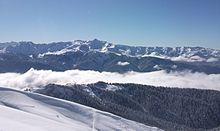Arabika Massif


Arbaika Massif (Arabika) is a glacially eroded karst outcropping of the Gagra Range, Abkhazia[note 1] in the West Caucasus, by the city of Gagra. The highest elevation - mountain Arabika is 2,656 metres (8,714 ft).[1] [2]
Geology[]
The 13-km-long massif is composed of Lower Cretaceous and Upper Jurassic limestones that dip continuously southwest to the Black Sea and plunge below the modern sea level.[3] The area is densely wooded, with large areas of both coniferous forest and mixed woodland.
The Arbaika contains a number of remarkable caves, gorges, wells, and precipices, including the Veryovkina Cave and Voronya Cave, the world's deepest caves. Alexander Kruber was the first to explore some of these features in 1909.
According to Rebecca Felix, the Arabica's "towering heights of limestone suggest the possibility of amazingly deep caves, boring the length of the massif and into the earth below its base".[4]
Notes[]
- ^ Abkhazia is the subject of a territorial dispute between the Republic of Abkhazia and Georgia. The Republic of Abkhazia unilaterally declared independence on 23 July 1992, but Georgia continues to claim it as part of its own sovereign territory and designates it as a territory occupied by Russia. Abkhazia has received formal recognition as an independent state from 7 out of 193 United Nations member states, 1 of which has subsequently withdrawn its recognition.
References[]
| Wikimedia Commons has media related to Arabika. |
- ^ Mta Arabika GeoNames
- ^ Great Soviet Encyclopaedia
- ^ Tabor, James M. (2010). Blind Descent: The quest to discover the deepest place on Earth. New York: Random House. p. 159. ISBN 978-1-4000-6767-1.
- ^ Felix, R. (2014). Exploring Caves. ABDO Publishing Company. p. 48. ISBN 9781629680453. Retrieved 2015-04-13.
Coordinates: 43°25′N 40°20′E / 43.41°N 40.34°E
- Mountain ranges of the Caucasus
- Mountain ranges of Abkhazia
- Abkhazia stubs
- Georgia (country) geography stubs
